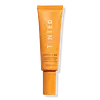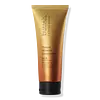What's inside
What's inside
 Key Ingredients
Key Ingredients

 Benefits
Benefits

 Concerns
Concerns

 Ingredients Side-by-side
Ingredients Side-by-side

Zinc Oxide 18.23%
Cosmetic ColorantWater
Skin ConditioningCaprylic/Capric Triglyceride
MaskingC13-15 Alkane
SolventPropanediol
SolventC15-19 Alkane
SolventBis-Diglyceryl Polyacyladipate-2
EmollientTocopherol
AntioxidantOctyldodecanol
EmollientPolyhydroxystearic Acid
EmulsifyingInositol
HumectantHippophae Rhamnoides Oil
EmollientSilica
AbrasivePolyacrylate Crosspolymer-6
Emulsion StabilisingIsostearic Acid
CleansingLecithin
EmollientPolyglyceryl-3 Polyricinoleate
EmulsifyingXanthan Gum
EmulsifyingCoco-Glucoside
CleansingPolyglycerin-3
HumectantPolyglyceryl-3 Lactate/Laurate
CleansingBisabolol
MaskingCaprylhydroxamic Acid
Sodium Dilauramidoglutamide Lysine
HumectantSodium Citrate
BufferingCitric Acid
BufferingArachidyl Glucoside
EmulsifyingSodium Phytate
Glycerin
HumectantPhysalis Alkekengi Calyx Extract
Skin ConditioningBiosaccharide Gum-1
HumectantSodium Levulinate
Skin ConditioningGlyceryl Caprylate
EmollientCetearyl Alcohol
EmollientT-Butyl Alcohol
PerfumingSodium Anisate
AntimicrobialGlucose
HumectantBeta-Carotene
Skin ConditioningBehenyl Alcohol
EmollientArachidyl Alcohol
EmollientCI 77492
Cosmetic ColorantCI 77491
Cosmetic ColorantZinc Oxide 18.23%, Water, Caprylic/Capric Triglyceride, C13-15 Alkane, Propanediol, C15-19 Alkane, Bis-Diglyceryl Polyacyladipate-2, Tocopherol, Octyldodecanol, Polyhydroxystearic Acid, Inositol, Hippophae Rhamnoides Oil, Silica, Polyacrylate Crosspolymer-6, Isostearic Acid, Lecithin, Polyglyceryl-3 Polyricinoleate, Xanthan Gum, Coco-Glucoside, Polyglycerin-3, Polyglyceryl-3 Lactate/Laurate, Bisabolol, Caprylhydroxamic Acid, Sodium Dilauramidoglutamide Lysine, Sodium Citrate, Citric Acid, Arachidyl Glucoside, Sodium Phytate, Glycerin, Physalis Alkekengi Calyx Extract, Biosaccharide Gum-1, Sodium Levulinate, Glyceryl Caprylate, Cetearyl Alcohol, T-Butyl Alcohol, Sodium Anisate, Glucose, Beta-Carotene, Behenyl Alcohol, Arachidyl Alcohol, CI 77492, CI 77491
Water
Skin ConditioningCaprylic/Capric Triglyceride
MaskingCyclopentasiloxane
EmollientPropanediol
SolventDimethicone
EmollientGlycerin
HumectantC12-15 Alkyl Benzoate
AntimicrobialPEG-100 Stearate
Glyceryl Stearate
EmollientCetyl Alcohol
EmollientHydroxyethyl Acrylate/Sodium Acryloyldimethyl Taurate Copolymer
Emulsion StabilisingGlyceryl Caprylate
EmollientCyclohexasiloxane
EmollientSucrose Cocoate
EmulsifyingCitric Acid
BufferingSodium Citrate
BufferingSodium PCA
HumectantGlyceryl Isostearate
EmollientAlumina
AbrasiveCaprylyl Methicone
Skin ConditioningPolyhydroxystearic Acid
EmulsifyingTriethoxysilylethyl Polydimethylsiloxyethyl Hexyl Dimethicone
Skin ConditioningLauryl PEG-9 Polydimethylsiloxyethyl Dimethicone
Skin ConditioningChlorphenesin
AntimicrobialIron Oxides
Allantoin
Skin ConditioningXanthan Gum
EmulsifyingCamellia Oleifera Leaf Extract
AstringentChamomilla Recutita Flower Extract
MaskingGlyceryl Undecylenate
EmollientPanthenol
Skin ConditioningPhytic Acid
Sodium Hyaluronate
HumectantWater, Caprylic/Capric Triglyceride, Cyclopentasiloxane, Propanediol, Dimethicone, Glycerin, C12-15 Alkyl Benzoate, PEG-100 Stearate, Glyceryl Stearate, Cetyl Alcohol, Hydroxyethyl Acrylate/Sodium Acryloyldimethyl Taurate Copolymer, Glyceryl Caprylate, Cyclohexasiloxane, Sucrose Cocoate, Citric Acid, Sodium Citrate, Sodium PCA, Glyceryl Isostearate, Alumina, Caprylyl Methicone, Polyhydroxystearic Acid, Triethoxysilylethyl Polydimethylsiloxyethyl Hexyl Dimethicone, Lauryl PEG-9 Polydimethylsiloxyethyl Dimethicone, Chlorphenesin, Iron Oxides, Allantoin, Xanthan Gum, Camellia Oleifera Leaf Extract, Chamomilla Recutita Flower Extract, Glyceryl Undecylenate, Panthenol, Phytic Acid, Sodium Hyaluronate
 Reviews
Reviews

Ingredients Explained
These ingredients are found in both products.
Ingredients higher up in an ingredient list are typically present in a larger amount.
This ingredient is an emollient, solvent, and texture enhancer. It is considered a skin-softener by helping the skin prevent moisture loss.
It helps thicken a product's formula and makes it easier to spread by dissolving clumping compounds.
Caprylic Triglyceride is made by combining glycerin with coconut oil, forming a clear liquid.
While there is an assumption Caprylic Triglyceride can clog pores due to it being derived from coconut oil, there is no research supporting this.
Learn more about Caprylic/Capric TriglycerideCitric Acid is an alpha hydroxy acid (AHA) naturally found in citrus fruits like oranges, lemons, and limes.
Like other AHAs, citric acid can exfoliate skin by breaking down the bonds that hold dead skin cells together. This helps reveal smoother and brighter skin underneath.
However, this exfoliating effect only happens at high concentrations (20%) which can be hard to find in cosmetic products.
Due to this, citric acid is usually included in small amounts as a pH adjuster. This helps keep products slightly more acidic and compatible with skin's natural pH.
In skincare formulas, citric acid can:
While it can provide some skin benefits, research shows lactic acid and glycolic acid are generally more effective and less irritating exfoliants.
Most citric acid used in skincare today is made by fermenting sugars (usually from molasses). This synthetic version is identical to the natural citrus form but easier to stabilize and use in formulations.
Read more about some other popular AHA's here:
Learn more about Citric AcidGlycerin is already naturally found in your skin. It helps moisturize and protect your skin.
A study from 2016 found glycerin to be more effective as a humectant than AHAs and hyaluronic acid.
As a humectant, it helps the skin stay hydrated by pulling moisture to your skin. The low molecular weight of glycerin allows it to pull moisture into the deeper layers of your skin.
Hydrated skin improves your skin barrier; Your skin barrier helps protect against irritants and bacteria.
Glycerin has also been found to have antimicrobial and antiviral properties. Due to these properties, glycerin is often used in wound and burn treatments.
In cosmetics, glycerin is usually derived from plants such as soybean or palm. However, it can also be sourced from animals, such as tallow or animal fat.
This ingredient is organic, colorless, odorless, and non-toxic.
Glycerin is the name for this ingredient in American English. British English uses Glycerol/Glycerine.
Learn more about GlycerinGlyceryl Caprylate comes from glycerin and caprylic acid, a fatty acid from coconut. It has emollient and emulsifier properties.
As an emollient, it helps hydrate your skin. Emollients work by creating a barrier on your skin to trap moisture in, helping to keep your skin soft and smooth.
On the other hand, emulsifiers prevent ingredients (such as oil and water) from separating.
Learn more about Glyceryl CaprylatePolyhydroxystearic Acid is a soft wax made from castor oil.
It is is a texture thickener, emulsifier, and film-former. Emulsifiers prevent ingredients from separating, such as oils and waters.
Polyhydroxystearic Acid may not be fungal acne safe.
Learn more about Polyhydroxystearic AcidPropanediol is an all-star ingredient. It softens, hydrates, and smooths the skin.
It’s often used to:
Propanediol is not likely to cause sensitivity and considered safe to use. It is derived from corn or petroleum with a clear color and no scent.
Learn more about PropanediolSodium Citrate is the sodium salts of citric acid. In skincare, it is used to alter pH levels and acts as a preservative.
Its main functions are to maintain the pH of a product and neutralize metal ions.
The acidity of our skin is maintained by our glands and skin biome; normal pH level of skin is slightly acidic (~4.75-5.5).
Being slightly acidic allows our skin to create an "acid mantle". This acid mantle is a thin barrier that protects our skin from bacteria and contaminants.
Learn more about Sodium CitrateWater. It's the most common cosmetic ingredient of all. You'll usually see it at the top of ingredient lists, meaning that it makes up the largest part of the product.
So why is it so popular? Water most often acts as a solvent - this means that it helps dissolve other ingredients into the formulation.
You'll also recognize water as that liquid we all need to stay alive. If you see this, drink a glass of water. Stay hydrated!
Learn more about WaterXanthan gum is used as a stabilizer and thickener within cosmetic products. It helps give products a sticky, thick feeling - preventing them from being too runny.
On the technical side of things, xanthan gum is a polysaccharide - a combination consisting of multiple sugar molecules bonded together.
Xanthan gum is a pretty common and great ingredient. It is a natural, non-toxic, non-irritating ingredient that is also commonly used in food products.
Learn more about Xanthan Gum